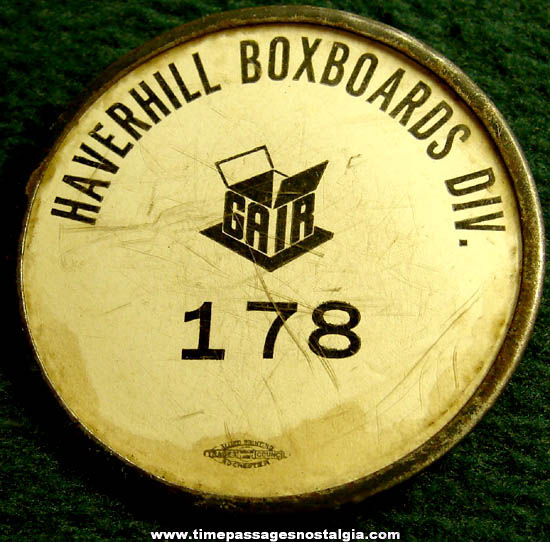
   | | Any group of items being offered as a lot must be sold as a lot. | | | Great memories
make great gifts! | All Original Items.
No Reproductions | | Quality Merchandise At Reasonable Prices | | Unique & Fun Nostalgic Items | Quantity Discount Prices
(when available) | Nostalgic Memorabilia, Pop Culture Artifacts, Historic Items,
and "Shoe Box Toys" | Quality Packing And
Postal Insurance | It's never too late to
have a happy childhood! |
| | | | The picture shows a view of this Old Gair Haverhill Boxboards Division Advertising Employee Badge. The badge is not dated but it is believed to be from sometime between the 1920s and the 1940s. The Haverhill Boxboard Company began in 1902. The Gair Company absorbed the Haverhill company in 1920 and we believe that the company closed for good in 2008. The badge is imprinted in black on a white background. There is a clear covering and a metal back and pin. The back is blank and the front has a printing union mark and a Gair box logo pictured. It is marked as follows: GAIR
HAVERHILL BOXBOARDS DIV.
178 This old employee badge measures 2'' wide. It appears to be in fair to good condition as pictured. The scratches are on the clear covering and the water spotting is on the paper inside. The badge looks well used and it could use a good cleaning. Below here is some additional Historical information that was found: Cardboard box
From Wikipedia, the free encyclopedia History The first commercial paperboard (not corrugated) box was produced in England in 1817, it is widely believed to have been produced by Malcolm Thornhill. The Scottish born Robert Gair invented the pre-cut cardboard or paperboard box in 1890. They were flat pieces manufactured in bulk that folded into boxes. Gair's invention came about as a result of an accident. He was a Brooklyn printer and paper bag maker during the 1870s, and one day, while he was printing an order of seed bags, a metal ruler normally used to crease bags shifted in position and cut them. Gair discovered that by cutting and creasing in one operation he could make prefabricated paperboard boxes. Applying this idea to corrugated boxboard was a straight forward development when the material became available around the turn of the twentieth century. |
|
Click on image to zoom.
 |